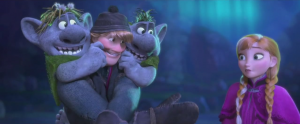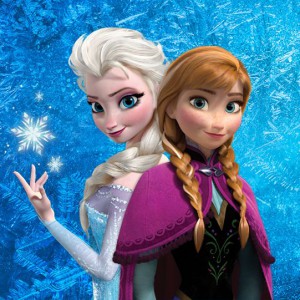Negotiations and Regressions of Cultural Politics in Disney’s Frozen
 Since even before its release in November of last year, Disney’s Frozen has been the subject of much debate surrounding the contemporary socio-cultural politics and positioning of Disney as a whole, and Walt Disney Animation Studios in particular. For the last several years, the studio’s former profile as a bastion of safe family entertainment—that is to say, media by and for moderately conservative Anglo-Americans—seems to be shifting somewhat. Where once Disney seemed to embrace all of (white) childhood, it has increasingly specialised its feature animated offerings within (white) girl culture. This is largely in step with both the televised media branding of the Disney Channel and the ever-growing Princess meta-franchise. It also corresponds with the Walt Disney corporation’s acquisition of Marvel in 2009 and Lucasfilm in 2012, as well as the commercial failure of John Carter in 2012 and The Lone Ranger last year. The Disney brand is still in the business of children’s entertainment as a whole, but through a mixture of circumstance and design, the most critically lauded and commercially viable filmic output to be released entirely under its own branding has been heavily and increasingly involved in female-centred narratives and their accompanying cultural politics.
Since even before its release in November of last year, Disney’s Frozen has been the subject of much debate surrounding the contemporary socio-cultural politics and positioning of Disney as a whole, and Walt Disney Animation Studios in particular. For the last several years, the studio’s former profile as a bastion of safe family entertainment—that is to say, media by and for moderately conservative Anglo-Americans—seems to be shifting somewhat. Where once Disney seemed to embrace all of (white) childhood, it has increasingly specialised its feature animated offerings within (white) girl culture. This is largely in step with both the televised media branding of the Disney Channel and the ever-growing Princess meta-franchise. It also corresponds with the Walt Disney corporation’s acquisition of Marvel in 2009 and Lucasfilm in 2012, as well as the commercial failure of John Carter in 2012 and The Lone Ranger last year. The Disney brand is still in the business of children’s entertainment as a whole, but through a mixture of circumstance and design, the most critically lauded and commercially viable filmic output to be released entirely under its own branding has been heavily and increasingly involved in female-centred narratives and their accompanying cultural politics.
For its part, and despite its neutered (spayed?) title, Frozen’s loose adaptation of “The Snow Queen” plays as a consolidation of this bent, with a plotline centred above all on a sororal relationship—one that is furthermore presented as the surprise lynchpin to the film’s climax in a winking subversion of Disney’s hetero-romantic narrative tendencies. Love saves the day again, but this time it is familial, sisterly love. This, in conjunction with the supposed LGBT-friendliness of “Let it Go”—its central, Oscar-winning musical set-piece—has created some renewed popular interest in the role of gender politics in Disney films.
For a while now, Disney has been negotiating a compromise between some of the more regressive social values it has attached to itself, and the need to maintain cultural relevance and dissuade potentially harmful critique. Frozen maintains the princesses, Eurocentrism and cookie-cutter character design (look at those tiny women and huge men), but places less emphasis on idealised heteronormative pairing in order to highlight other modes of female characterisation. In the context of Hollywood, and Disney in particular, this is commendable. At the same time, it shouldn’t be taken in any way as if it is at the vanguard of media representation within these parameters. It is simply indicative of symptomatic shifts within an otherwise largely entrenched ideological core.
The extent of this entrenchedness is most visible when examining how more recent Disney fare treats modes of representation discursively detached from girlhood’s growing importance in Disney’s media profile. In Frozen itself, this may be seen in the construction of ethnic/cultural otherness implicit in the film’s troll characters. Magical, familial, communal, amiable, open and deferential to the film’s human characters, Frozen’s trolls fulfill a checklist of characteristics distinctive of subservient cultural others, particularly of the type that serve narratively to facilitate white people’s ability to love and understand each other better thanks to their intuitive wisdom and connection to the natural world. In the trolls’ case this is both symbolic and literal, with the characters themselves being composed of living rock. In terms of performance, this communal otherness is accentuated by the ways in which the trolls act as a collective unit, scrambling and speaking over each other, often in the evident voices of non-white performers —all supremely interested and supportive of the protagonist’s agenda and eager to play matchmakers for her.
This characterisation is all the more notable for the contrast it presents to the behaviour and attitudes that inform the basis of the film’s main interpersonal conflicts, all of which are centred on intra-familial secrecy and individual self-control and denial. Indeed, the main conflict of Frozen is possibly the whitest to ever happen in a Disney film, based as it is in problems predicated by a conception of whiteness that sees itself in opposition to the raucous, communal earthiness so often attributed to other cultures and ethnicities, particularly those of Black, Hispanic and Mediterranean heritage. Throughout such conflicts, whites overcome the trappings of their over-civilisation by balancing them with the subservient wisdom freely offered by cultural others. In perpetuating these narrative relationships, Disney in particular and Hollywood in general demonstrate how relative discursive progression in some areas (or freedom for interpretation, as in Let it Go’s adoption as a coming out anthem) comes with little regard for entrenched regressive values in others. While Disney’s female characters have begun ever so slightly to shed their role as satellites to male protagonists, other modes of otherness persist in much the same way as they have since Song of the South. It’s almost as if Disney’s perception of cultural otherness is immobile. Petrified or static, if you will.


